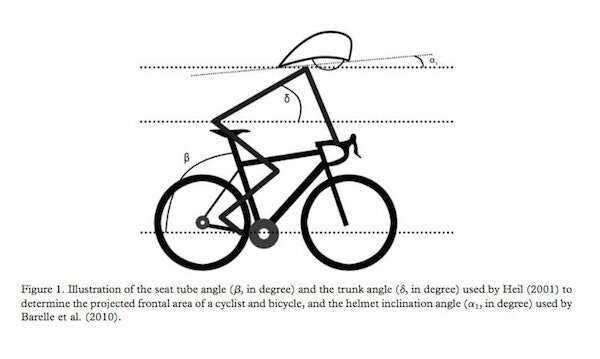At what speeds do aerodynamics make a difference on a bicycle?
At speeds over 10 mph (16 kph), aerodynamic (aero) drag becomes the dominant force of resistance, with no wind on flat terrain:
At 18 mph (29 kph) it becomes 80% of the resistance
25 mph (40 kph) it becomes 90% of the dominant force
At 6 mph (10 kph) air resistance becomes a discernible resistance factor (but less than rolling resistance)
Speed & aero drag
What about at speeds below 10 mph?
At speeds below 10 mph (16 kph) rolling resistance is the dominant force of resistance.
When most cyclists and riders think of rolling resistance their first thoughts goes to their tires and tire pressure. However, rolling resistance is the force that comprises the drag arising from all energy losses from the mechanics of your bicycle. This includes energy losses from:
Frame flex
Drivetrain resistance (chain, gears, bearings)
Crank losses
Tires
Cyclist mass (vertical load on the tire)
Wider tires with lower PSI, knobby tread, and a smaller diameter have the highest rolling resistance of any bike tire.
Put into plain English, this means mountain bike tires are slow.
Unlike air resistance, which increases as your speed increases, rolling resistance is nearly constant regardless of your speed. If you are riding a road bike with narrow and properly inflated tires on smooth pavement, your rolling resistance is hard to measure since it plays such a small part of total drag on a moving bicycle.
“Rolling resistance is the reaction force acting on the bicycle due to the interaction between the mountain bike tyre and the terrain surface it is traveling on.”
What is aerodynamic drag as it relates to cycling?
Aerodynamic (aero) drag is a complex topic. Among triathletes and elite cyclists, nothing is discussed more than the topic of aerodynamics. Aero drag is an invisible force, and can only be measured in laboratory settings.
Aerodynamic drag is the resistive force of the air rushing past you. This aero drag pulls on you from behind. There are four aspects to aero drag:
“The projected frontal area represents the portion of a body which can be seen by an observer placed exactly in front of that body”
Air density - air is ‘thicker’ at sea-level and gets ‘thinner’ as you climb in altitude. Air density at 7400 feet (2,255 m) is 20 percent less than at sea level, where cycle speeds are 3 - 5 % faster. (7400 feet is the elevation of Mexico City, Mexico)
Airspeed of your bike
Bike + rider’s aero drag coefficient
Rider’s frontal area - are you a brick or a blade
Airspeed, drag coefficient, and projected frontal area are incredibly complex factors. However, it should be noted that aerodynamic drag increases as the square of the velocity.
This means that as your speed is doubled, twice as many air molecules are encountered, and you hit them twice as fast.
To put this into context, a cyclist traveling at 20 mph (32 kph) will only increase their speed by 6 mph (10 kph) with double the power output. Increasing your power-output makes you faster up to a point, but aerodynamic improvements ALWAYS make you faster.
If you want to ride faster and keep your chain clean than the only lube of this downhiller is Pedaling Science’s Bike-specific Chain Lube
How do I become more ‘aero’ ?
Your bicycle is responsible for about 30% of the resistance forces from aerodynamics, while the rider is responsible for the remaining 70%. This means the greatest improvements in becoming ‘aero’ come not from bicycle modifications, but from you, the cyclist:
“As previously stated, Kyle & Burke found that rider position has the largest contribution to aerodynamic drag.”
Improved riding technique
Riding posture/position
Largest factor in aero drag
Aero reductions over 30%+
Wearing aero apparel (every piece of clothing impacts aerodynamics more than you think)
Proper bike-fit
Skin hair
Drafting - Drafting alone reduces aero-drag by nearly 30%
Posture is everything while cycling
These 6 factors and all the complex subcategories affect your aerodynamic drag by 70 percent. Just reducing your aero drag by 5% will save you at least 60 seconds per 25 miles of riding (40 km).
Going out and buying the latest and greatest bike will result in zero performance gain.
However, wearing a streamlined helmet, shoes, shorts, and shirt, while also improving your riding posture, you can cut your aero drag in half.
How important is aerodynamics to cycling???
The Union Cycliste Internationale (UCI) is the world governing body for cycling and regulates international competitive cycling events. From 1984 to 2000, the UCI revised and modified over a dozen rules related to aerodynamics.
The ability to manipulate this one variable can be the difference between winning or not even being invited to the event.
Aerodynamics are the single largest resistance force once you reach speeds of 10 mph. Even out of shape beginner cyclists will average 12 mph (19 kph) or more on flat terrain.
Jesse (Director of Pedal Chile) lives in Chile’s Patagonia. Jesse has a Master of Science in Health & Human Performance and a Bachelor of Science in Kinesiology. Hobbies: Mountain biking, snowboarding, reading, writing, and researching about aerodynamics and bicycling.
Sources:
“Aerodynamic Drag in Cycling: Methods of Assessment.” Sports Biomechanics, vol. 10, no. 3, Sept. 2011, pp. 197–218. (figure 1 source)
Burke, Ed. Science of Cycling. Champaign, Ill., Human Kinetics Publishers, 1986.
Cycling Science. Champaign, Il, Human Kinetics, 2017.
David Gordon Wilson. Bicycling Science. Cambridge (Massachusetts), Mit Press, 2004.
Lukes, R. A., et al. “The Understanding and Development of Cycling Aerodynamics.” Sports Engineering, vol. 8, no. 2, Dec. 2005, pp. 59–74.
South African Journal for Research in Sport, Physical Education and Recreation, 2014, 36(2): 179-193 link




















